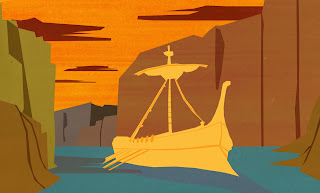After re-watching JAWS a couple of nights ago I decided to go back over it and analyse some of the scenes which I thought were interesting.
Chief Brody Introduction:
Charcoal and pen rough storyboard
I really like the way Chief Brody is introduced into the film. The transition from night time to daytime is very simple but it works brilliantly in slowing down the pace of the film from shark attack scene. The shot is then held as Brody is heard waking up and rises into frame. The editing takes us right inside his house without ever moving the camera away from the sea, simple and effective. The next shot then establishes that Chief Brody is in his bedroom with his wife. Note how his head is still framed within the window, it makes it clear which person we should be looking at and also provides some continuity for the audience to follow.
Finding The Body at The Beach:
This scene shows Chief Brody and the teenager finding the girl's body at the beach. I particularly like this scene for several reasons.
At the start of the scene the weather is very pleasant like a typical summers day. The sea too is calm and the horizon remains low and harmless. However, once they come across the body the weather begins to turn grey and windy. The sea then takes up a lot more of the frame and as a result feels ominous and threatening. The final shot shows a nervous Brody in front of the sea which dominates the frame, it almost looks like the sea is going to drown him. It also implies Chief Brody's fear of the sea.
Spielberg also builds tension and anticipation into the scene by deliberately focusing on the reactions of the characters to the girl's body. Only afterwards does the audience then see what they can. In this case however, all the audience can see is a hand in the sand. It is left to the imagination to fill in. This is ultimately more effective than revealing everything as the imagination can often conjure up much more terrifying images than what could be seen on screen. These tricks are used frequently in Spielberg's films. Think of Jurassic Park when we see the reactions of everyone on the Jeep tour first before seeing the dinosaurs for the first time.
Charcoal and pen rough storyboard
Lastly, I really like the 5th image in the sequence above from a visual storytelling point of view. There is the distressed officer in the foreground and the other two behind the fence in the background. The jagged diagonal fence feels very threatening as it points towards the two. Would it be too far to suggest that they look as if they are inside the jaws of a mouth? Again the sea behind them is swallowing the frame ominously too.
Ferry Confrontation
This scene is a good example of visual storytelling too. It shows the mayor undermining Brody's power as a Police Chief by insisting that the beaches remain open. This is emphasised on screen by keeping Brody to the extreme left of the screen whilst the Mayor and his men crowd around him. Simple but very effective.
Clever Editing with the Environment
I love this sequence of Brody trying to keep an eye on what is happening in the sea, the edits match his increased nervousness perfectly. As Brody stares at the sea, passers by provide these natural wipes to switch views and as he becomes more anxious, the wipes become more frequent and zoom in on Brody to build tension. By utilising the environment Spielberg has created a much more interesting sequence than if it were normal cuts between views.
Lastly, I noticed that before every death in the film we are told a little bit of information about each person. It isn't not much, usually we overhear a conversation or a name but by doing so the audience become more invested in the character and therefore care more when they die. I think this is something that is often ignored in many films and almost impossible in big budget superhero films (think of all the innocent bystanders!).
Wow, that turned out a bit longer than I expected. Anyway, if you haven't seen JAWS you should just go out, buy the DVD and watch it. It is a superb example of storytelling, film making and editing.




















































